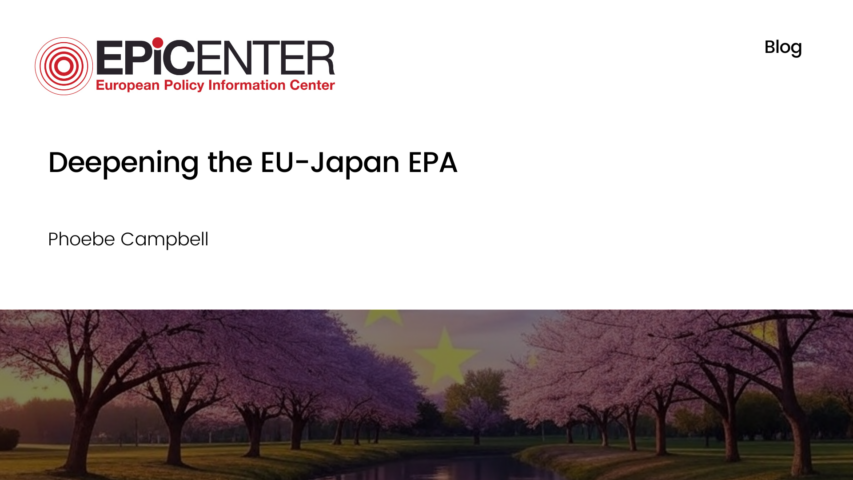Deepening the EU-Japan EPA

Deepening the EU-Japan EPA
Phoebe Campbell // 13 September 2021
The EU and Japan are like-minded: both support a rules-based, open global trade system and share similar values on democracy, freedom of expression and privacy. In previous years, though, trade between the EU and Japan was strained: Japan’s share of EU goods exports saw a decline (6.9% in 1990 to 3.2% in 2017) while European firms faced trade barriers exporting to Japan. In July 2018, the EU and Japan signed a trade deal, the Economic Partnership Agreement (EPA), one that covered 600 million people and 30% global GDP as the 2nd (EU) and 4th (Japan) richest economies joined forces. Following the example of the recent UK-Japan deal, EU-Japanese trade negotiators should gather again to build further on the EPA’s success, particularly looking to cooperate on data privacy.
Under the EPA, the EU and Japan committed to gradually removing 99% and 97% of tariff lines on goods respectively, making it easier for both sides to sell goods and services to each other. At the time, some media commentators dubbed it the ‘cars for cheese’ deal: Japan agreed to gradually removed trade barriers imposed on the EU’s agricultural products while the EU pledged to gradually remove the 10% tariff on Japanese cars over a seven-year period.

Data (graph above) suggests that since the EPA, the EU’s total exports to Japan (62.6 million euros) and EU imports of goods (63 million euros) reached record highs in 2019, with the largest contribution coming from France (30% of total increase). The geopolitical effects of the EU-Japan EPA were also significant. Negotiations for the agreement gained heightened political importance following, and in opposition to, Trump’s unilateralism and ambivalence to multilateral trade liberalisation. The bilateral EPA sent out a clear message of the EU and Japan’s commitment to cooperate, uphold a liberal world order and push back against US protectionism. In a joint statement this year following the EU-Japan Summit, both expressed ‘a general satisfaction’ with the EPA’s positive results ‘despite the impact on global trade due to the COVID-19 pandemic’ and reaffirmed that ‘full and effective implementation of the EPA remains a joint priority’.
Compared to other negotiations at the time, such as the proposal for the Transatlantic Trade and Investment Partnership (TTIP), the EU-Japan EPA was met with relatively little backlash. This was not only due to the improved transparency of the negotiations process, but also due to the fact of more evenly distributed beneficial effects on member states and different sized exporters.
Now three years on from the initial signing, the EU and Japan should gather again to further their well-established agreement and commitment to cooperation. They should follow the example of the UK-Japan Comprehensive Economic Partnership Agreement (CEPA) signed after Brexit, a deal which did not only maintain the benefits of the EU-Japan EPA but also went further, including a chapter on digital trade and data privacy. The EU and Japan, with other like-minded countries, should also coordinate a liberal approach to digital trade. In fact, Article 8.81 of the EPA spelled out the expectation that both parties should reassess data flow provisions under the EPA within three years, having previously failed to come to a concrete agreement at the initial signing.
Aligning with the EPA’s high standards of fair, open, rules-based trade, the EU and Japan should promote openness and transparency in connectivity and co-operate on standards of protection for the cross-border flow of goods, services and data in the global digital economy. This would send a clear message from the EU and Japan that a commitment to defend democracy and data protection is gaining increasing importance at a time when China is promoting an alternative value system.
Overall, while the EU-Japan EPA has been successful so far, both parties should look to deepen their agreement, following the example of the UK-Japan CEPA. Reaching a concrete policy on digital trade, and especially trust in data flows on the global level, would allow them to take their cooperation even further than the current EPA in place.
EPICENTER publications and contributions from our member think tanks are designed to promote the discussion of economic issues and the role of markets in solving economic and social problems. As with all EPICENTER publications, the views expressed here are those of the author and not EPICENTER or its member think tanks (which have no corporate view).



